|
ANIAKCHAK
Beyond the Moon Crater Myth A New History of the Aniakchak Landscape A Historic Resource Study for Aniakchak National Monument and Preserve |

|
EARLY AMERICAN PERIOD (1867-1930)
CHAPTER SEVEN
The Knights of Woeful Countenance:
Fox Farmers, Local Trappers, and Clam Canners
Displaced from their places of birth, cheated in the states, unemployed hungry, thirsty, these knights of woeful countenance found and up to now find a warm and hospitable corner in cold Alaska; having set aside all sorts of dreams about family life, they unexpectedly find a warm family hearth, by marrying local creoles or Aleuts—and start with their progeny a new generation of Orthodox creoles while they themselves remain heterodox: Lutheran, Episcopal, Catholic, and other erring Christians.
from the American Orthodox Messenger, 1898
When Father Hubbard and his crew finally made it to Aniakchak in 1930, they encountered a mix of Alutiiq, Russians, and Euroamericans living together on the outskirts of the volcanic region. According to his assistant, Dick Douglas, it was the Euroamericans with whom the explorers identified. "The only other people who ever go near the mountain," observed Douglas, "are the few hardy men who make their living trapping for furs in winter, and when summer comes, go out in their fishing boats to net salmon in the Bering Sea." [1] These so-called "hardy men" were the same group the Russian Orthodox priest, Father Kedrovskii, described in 1898 as being displaced from their places of birth, cheated in the states, and unemployed. Because they had endured great hardships for most of their lives, the priest referred to these men as "the Knights of Woeful Countenance."
According to Russian Orthodox Church records, men with surnames such as Anderson, Johnson, Brandel and Erikson represented some of the many non-Orthodox males living in the Chignik Lagoon/Nikolaevskoe area between 1899 and 1914. [2] These Knights of Woeful Countenance were intimately linked to the experience of many nineteenth century immigrant Americans. In the years before 1899, if most Americans even thought of Alaska, they hardly considered the territorial acquisition a "last frontier," but rather, they saw it as nothing more than a frozen wasteland, or the popularized "ice box." During the decades marked by the Gilded Age, from approximately 1870 to 1900, interest in the wilderness frontier as a source of opportunity had diminished and was replaced with a heightened interest in technological frontiers. For many working class Americans, technological progress and rapid industrialization promised a better life. By the booming years of the early 1880s, as historian Morgan Sherwood put it, "the old dream that Alaska's 'free land' would serve the function of the Old West, in a Turnerian sense, all but vanished." [3]
As Americans entered the last decade of the nineteen century, however, the promise of a good life began to falter. For years, political corruption controlled policy at all levels of government. Corporate industrialization and mechanization had begun to alienate workers. Those workers who unionized pushed numerous ethnic groups even further onto the margins of mainstream society. And, most significantly, economic depression, followed by the stock market panic of 1893, caused high unemployment and widespread misery throughout the nation.
By the late-1890s, the cold and lifeless image of Alaska had changed dramatically, especially after the advent of the enormously famous 1897 Klondike gold strike, which presented new opportunity for down-on-their-luck Americans. As stories of mother-lode finds filtered down into the Lower 48, writers of the time quickly began to link the Far North to the nation's frontier saga. Suddenly, as cultural studies scholar Susan Kollin notes, "Alaska was positioned to encode the nation's future, serving to reopen the western American frontier that [Frederick Jackson] Turner closed in the 1890s." [4] Inspired by stories spawned by gold panners, Alaska was thrust into its most potent role—it promised to provide a nation plagued by economic despair with opportunities for renewal.
Reflecting this new interest in the Far North, between the late-1890s and the 1930s, the Aniakchak region saw an increase of American newcomers, especially those with roots in Norway, Sweden, Denmark, and Finland, who sought a chance to begin anew. Unlike the newcomers who came to the Aniakchak region in short seasonal spurts to work for the canneries, these newcomers tended to make the Alaska Peninsula their home. They married local Alutiiq women and raised their children near cannery towns. In doing so, they founded families that today make up most of the populations of Chignik Bay and Chignik Lagoon. [5]
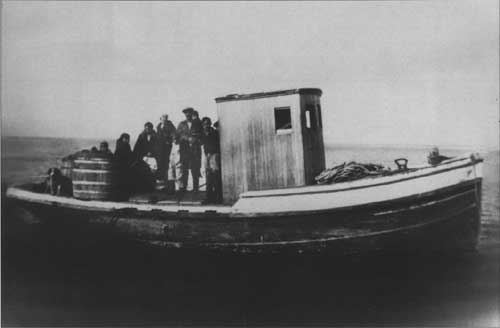
|
| Small boat used by Chignik residents to access the Aniakchak coastline and nearby islands, ca. 1920s. Photograph courtesy of Alec (Teetum) Pedersen, Chignik Lagoon, Alaska. |
The new "Scandinavian-Aleut" families, as they came to be called, settled into a lifestyle that Partnow describes as a "mixture of Alutiiq, Russian, and American practice." [6] The Knights of Woeful Countenance respected communal obligations to the village regarding shared subsistence resources, and as a result, Alutiiq villagers welcomed them into village life. Raised within the mindset of a Protestant work ethic, many of the Scandinavian-Americans harbored strong feelings against lavish displays of wealth and, therefore, acculturated nicely into an inclusive and intense village social structure. [7] From their Alutiiq relatives, these Euroamericans learned the language, the most efficient ways to dress, and how to hunt for Aniakchak's numerous fur-bearing mammals. Chignik Lagoon elder, Julius Anderson, recalls how his Danish grandfather introduced aspects of his Scandinavian heritage to the village:
You know, my grandpa used to have a sod house at the lagoon. They used fish traps way back then, when he first came. He was Danish. He came over on the Star of Alaska. ...I think a lot of the great grandfathers from around this area came from the old country. They introduced a lot of the Scandinavian ways of preserving fish, smoking it, salting it, rather than just buying it. Like lutefisk, my grandpa used to make lutefisk. He always did a lot of salted salmon, herring. [8]
Over time, however, the village's position as the basic economic unit began to slip as people moved from place to place looking for wage-paying jobs. By the first decade of the century, the single Scandinavian-Aleut family was actively engaged in occupations such as fox farming, trapping, clamming, and commercial fishing. Though rooted in Alutiiq economic lifeways, these activities were now occupations that had been incorporated into the American market system. As Partnow observes, the new economic reality had a large impact on social organization, for suddenly people's "lives revolved around economic pursuits especially suited to the nuclear family." [9]
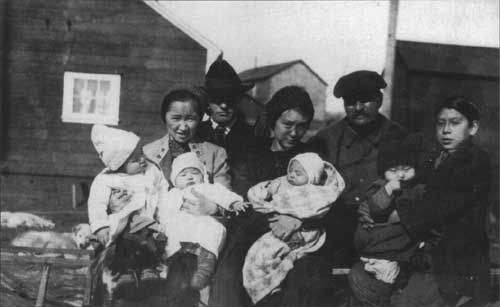
|
| Families on the central Alaska Peninsula reflected a blending at cultures. Tootsie Griechen, Gust Greichen (with pointed hat), and Bill Brown (flat hat), Alice and Aleck Griechen (babies on Tootsie's lap). The four others are unidentified, ca. 1920s. Photograph courtesy of the Pilot Point Tribal Council, Ace Griechen Collection. |
By the turn of the century, families were crisscrossing the peninsula to work at canneries in Chignik and Egegik in the summer. In the winter months, those same families would live solitary lives running trap lines. Many even lived on isolated islands off the coast of Aniakchak, managing fox farms year round. Though economic constraints forced many families to live independently, at some time during the year, many families returned to the village, re-entering a social community that was based on a combination of pre-contact and Russian-era practice. But, as the need for steady income increased, families moved farther away from the village for longer periods of time and shared less and less with their Alutiiq cousins. Less sharing allowed some families to accumulate a degree of wealth. With the accrual of capital, a new socioeconomic class emerged in the Aniakchak region.
Thus, by 1917, when the Columbia River Packers Association moved into Aniakchak Bay, these men and their families were actively using the area on a seasonal basis. Though it was the fishing industry that originally attracted them, many Euroamericans were able to remain permanently in the region based on fox farming, fur trapping, and, to a much lesser degree, clam canning activities. These pursuits became important ways of life and a means of income.
Fox Farming
In 1930, while heading down the Alaska Peninsula en route to Chignik, Dick Douglas found it strange that the steamship on which he was sailing had stopped so late in the evening. As a faint light lay over the water, the ship dropped anchor in the lee of a little island and blew her whistle. Before the echo of the whistle died away, Douglas heard the creak of oars and then spotted the dark outline of a dory moving gracefully out to meet the boat. As the young explorer watched the single rower make his way across the bay, he heard foxes yapping somewhere on the island. In a few minutes the dory docked at the side of the ship. A Native boy who had boarded the ship at Seward slid down a rope into the dory, and without a word took the oars from the much older rower. Responding to Douglas's confusion, the first mate standing along side him at the rail, explained "the old fellow raises foxes on the island. The boy there, his son, has been in school at Seward all winter." [10] Although Douglas looked forward to exploring the primitive world of Aniakchak with Father Hubbard, he, nevertheless, was observing a people fully engaged with the modern world.
* * *
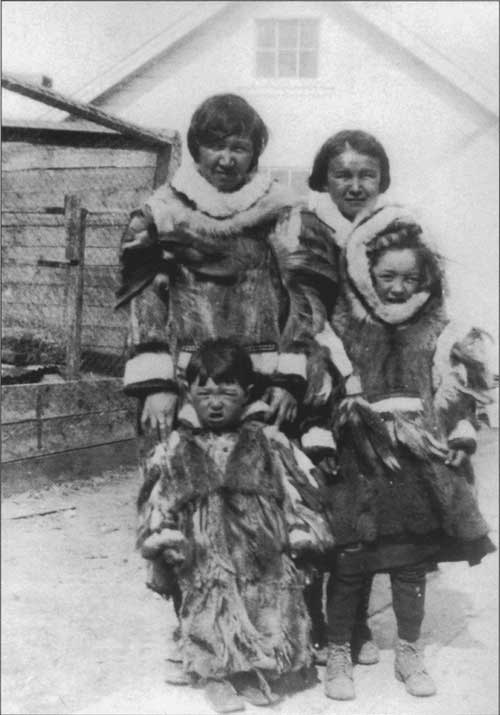
|
| Tootsie Griechen, Sassa Blandov, Alice Greichen, and Aleck Greichen, date unknown. Photograph courtesy of the Pilot Point Tribal Council, Ace Griechen Collection. |
In its last gasp to remain active in the fur trade, the Alaska Commercial Company initiated a new type of commercial enterprise—fox farming—which renewed market interest in fox fur. The first recorded introduction of foxes onto Alaska islands was made by a private entrepreneur on Popof Island in the Shumagin Islands in about 1880. One year later, the Alaska Commercial Company released Arctic foxes from the Pribilof Islands in the Semidi Islands, located just off the coast of Aniakchak Bay. [11] It is well known that both Alaska Natives and Russians introduced foxes to numerous islands in the region. Although it is unclear how these early ventures impacted island ecosystems, Steve Ebbert, a U.S. Fish and Wildlife biologist, notes "certainly the Aleutian Canada goose nested on many of these islands, and to this day only nest on one Island (Kiiktagik) in the Semidi group." [12] This circumstantial evidence, Ebbert points out, is an example of a permanent change that could have occurred because of earlier, unrecorded stocking of fox on coastal islands.
The Semidi Islands seemed the perfect location for foxes, for at that time the fur trading company was still sending small parties of Natives from Sutkhum to the offshore islands to hunt seal and seal lions during the summer months. After removing the furs from their catch, hunters simply left the carcasses behind for the foxes to eat. [13] The system proved profitable, and as a result, the Alaska Commercial Company organized the Semidi Propagating Company in 1885. [14] This was the first successful fox farming operation in the region, and by 1900, the islands supported about 1,000 foxes. [15]

|
| Chignik Lagoon elder, Julius Anderson. Anderson is a son of the "knights of woeful countenance"—his mother was from Wrangell Bay near Kanatak and his father was from Norway. 2004 Photograph courtesy of Katherine Johnson Ringsmuth, Anchorage, Alaska. |
By the turn of the century, fox farming had grown rapidly, not only in southwest Alaska, but throughout the entire territory. With the increasing need to protect the dwindling fur seals and sea otters, President Taft signed an executive order in March 1913, which created the Aleutian Islands Reservation. The purpose of the reserve maintained paradoxical goals, for it was established to preserve breeding grounds for native birds and for the propagation of fur-bearing animals. With encouragement from the federal government, fox farming quickly escalated as an alternative commodity for the insatiable international fur market. Between 1890 and 1914, the Semidi Propagation Company alone harvested 5,100 Arctic foxes mainly in the Semidi Islands and the Kodiak archipelago. [16]
As with the pelagic fur hunters, regional fox farmers profited from growing fashion trends spreading throughout Europe and the United States. In the decade known today as the "Roaring Twenties," fashion trends especially for women were glamorous and sophisticated. To attend the theater or a trendy nightclub, women accented their silk dresses with draped furs, used furs as fringe for the popular wrapover coats, or if very wealthy, had entire outerwear made from the fox fur. Because furriers increased demand on both sides of the Atlantic, by 1925, a prime breeding pair could sell as high as $34,000. That same year industry experts valued 391 fox farms, with over 36,000 foxes, at $6 million. In a few noted cases, individual pelts of silver foxes sold for $2,800 in London. [17] In a fur trader's industry magazine published in the 1920s, reviewer Harriet Rossiter acknowledged that Alaska's fur farms were operated by the "keenest business men in the territory," but it was the female consumer who made Alaska's fur industry a successful business:
The feminine portion of Uncle Sam's big family has already shown an encouraging preference for blue fox skins, perhaps because their genuineness is guaranteed by their color, which no dye can reproduce. Or perhaps they realize how the fine, silky fur and beautiful soft color enhances their charms. [18]

|
| Father Hubbard published three books that depicted his adventures in Alaska. In, Cradle of the Storms: Adventure in the Aleutians, the Glacier Priest includes chapters of his adventures in Aniakchak, specifically chapter one, "Flying the Lide of Hades," which described his flight into the erupting caldera in 1931. Published by Dodd, Mead & Company, 1935. |

|
| Satellite over Aniakchak, 1992. Photograph courtesy of Tina Neal, USGS, Anchorage Alaska. |
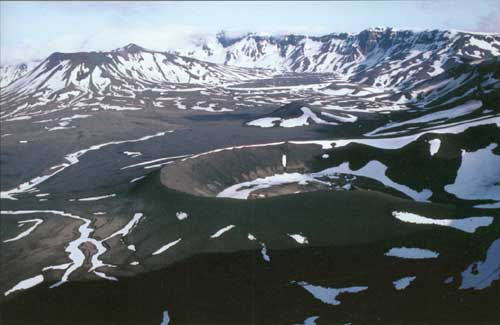
|
| The site of the 1931 crater with Vent Mountain in the background, 1992. Photograph courtesy of Tina Neal, USGS, Anchorage Alaska. |
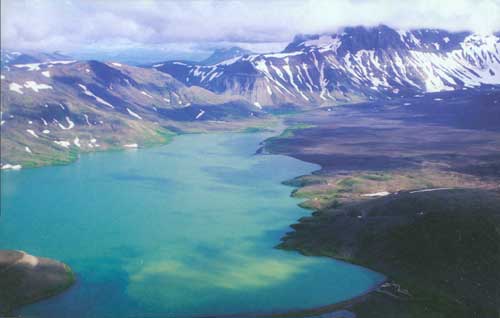
|
| Aniakchak Caldera and Surprise Lake, 1933. Photograph courtesy of Game McGimsey, USGS, Anchorage, Alaska. |
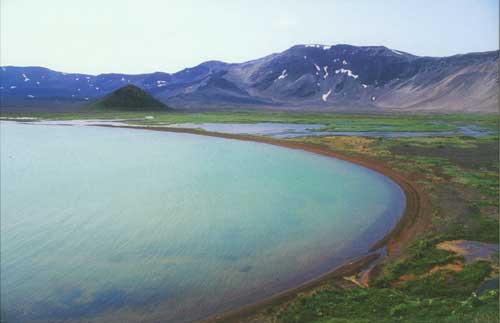
|
| Hubbard Cove, west end of Surprise Lake, 1993. Photo courtesy of Game McGimsey, USGS, Anchorage, Alaska. |
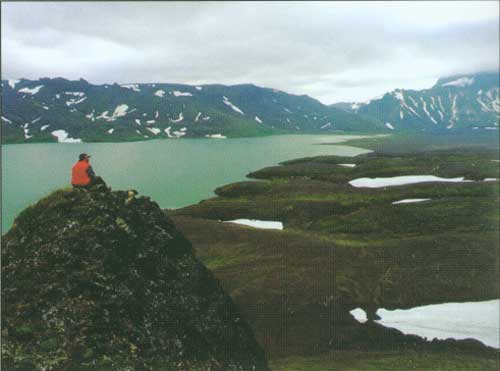
|
| Peace in the Caldera. Photograph by Troy Hammon, NPS. |

|
| Aerial of the Gates of Aniakchak Caldera, ca. 1996. Photograph courtesy of Game McGimsey, USGS, Anchorage, Alaska. |
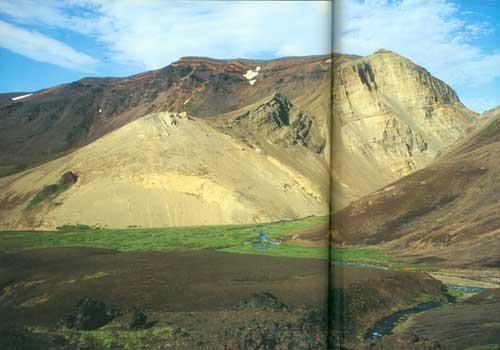
|
| A landslide block of the Gates, ca. 1996. Photograph courtesy of Game McGimsey, USGS, Anchorage, Alaska. |
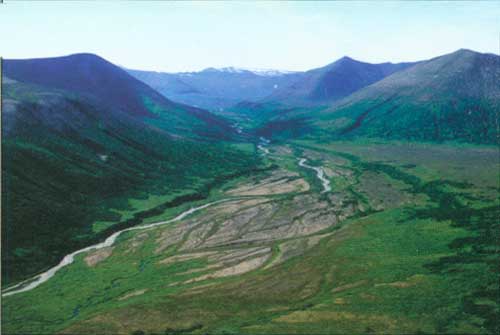
|
| Aerial view looking NW up Aniakchak River shows the destructive force of the wave that drained the ancient crater lake years ago, 1994. Photograph courtesy of Game McGimsey, USGS, Anchorage, Alaska. |

|
| Pinnacle Peak, 1994. Photograph courtesy of Game McGimsey, USGS, Anchorage, Alaska. |
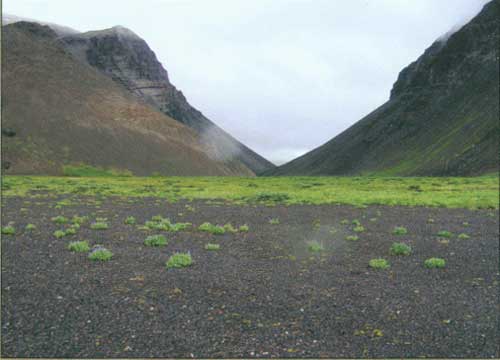
|
| The Gates. Alan Bennett, NPS Southwest Alaska Network, Anchorage, Alaska. |

|
| One of the "house-sized boulders" carried by the 1800 BP wave to the mouth of the Aniakchak River, 1994. Photograph courtesy of Game McGimsey, USGS, Anchorage, Alaska. |
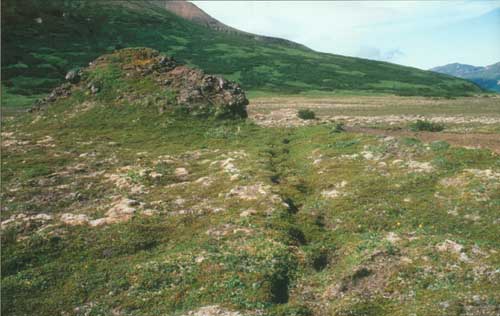
|
| The greening tundra and bear tracks show that Aniakchak's Living World is thriving on the northern terrace adjacent to Aniakchak Caldera, 1994. Photograph courtesy of Tina Neal, USGS, Anchorage, Alaska. |
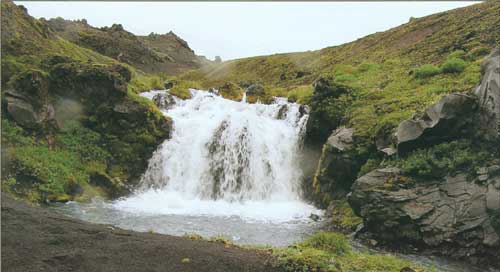
|
| Waterfall. Alan Bennett, NPS Southwest Alaska Network, Anchorage, Alaska. |

|
| The Aniakchak River. Alan Bennett, NPS Southwest Alaska Network, Anchorage, Alaska. |

|
| USGS conducts research inside the caldera, ca. Photograph courtesy of Tina Neal, USGS, Anchorage, Alaska. |

|
| A catastrophic terrain. Alan Bennett, NPS Southwest Alaska Network, Anchorage, Alaska. |
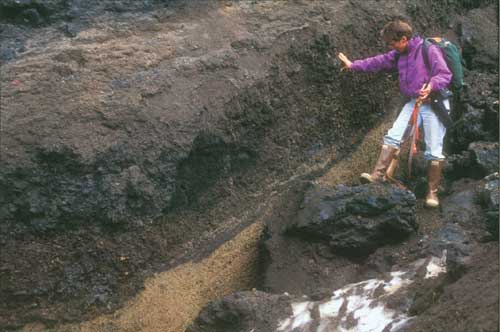
|
| Geologist Tina Neal investigates a rock formation at Half Cone, 1933. Photograph courtesy of Game McGimsey, USGS, Anchorage, Alaska. |
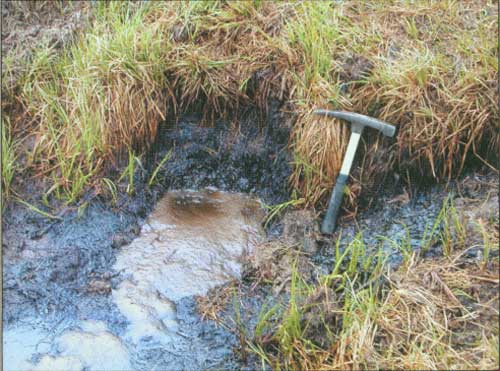
|
| Natural oil seeps near Kanatak, ca. 2004. Photograph Courtesy of Roger Blodgett, USGS, Anchorage, Alaska |
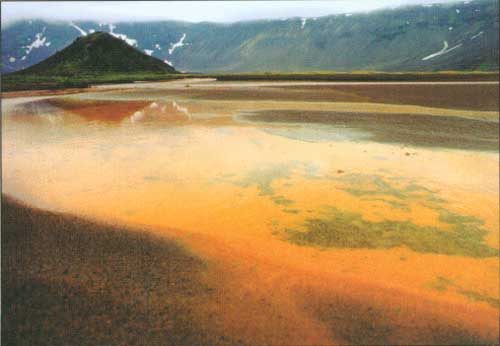
|
| Surprise Lake. Photograph by Troy Hammon, NPS. |
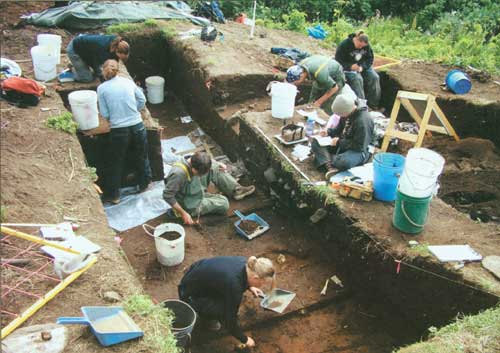
|
| Archeological excavation of a house floor in Aniakchak, 2005. Photograph courtesy of Brian Hoffman, Hamline University. |
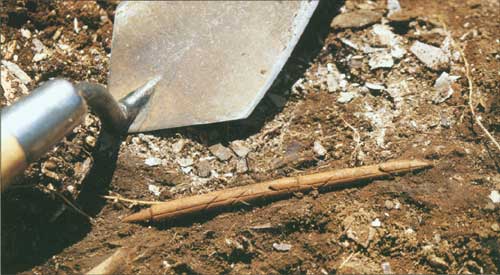
|
| Barbed arrow point found by archeologists, 2005. Photograph courtesy of Brian Hoffman, Hamline University. |

|
| A small ivory maskette possibly made to be worn by a doll, 2005. Photograph courtesy of Brian Hoffman, Hamline University. |
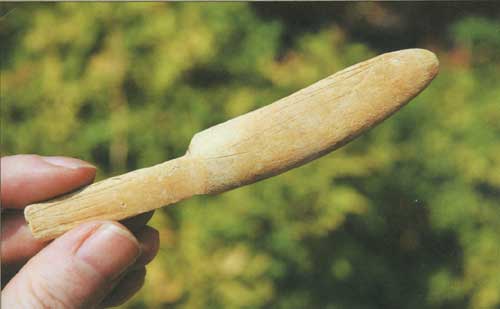
|
| Bone knife found by archeologists, 2005. Photograph courtesy of Brian Hoffman, Hamline University. |
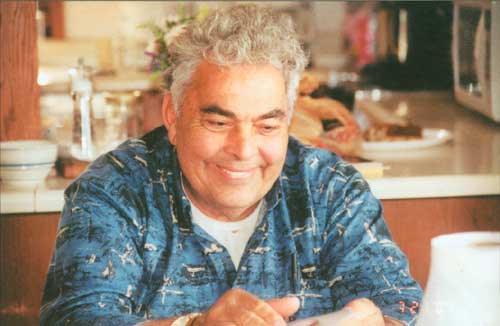
|
| Chignik Lagoon elder Clarence (Bobby) Erikson's family trapped in Aniakchak, 2004. Katherine Johnson Ringsmuth. Lake Clark Katmai Studies Center, Anchorage, Alaska. |
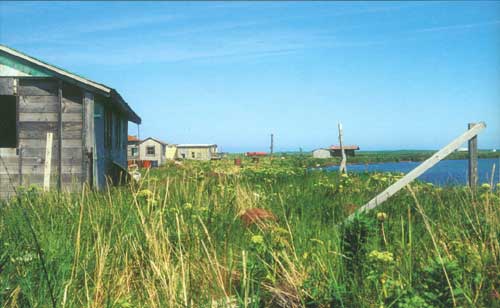
|
| Village of Meshik, 1996. Photograph courtesy of Tina Neal, USGS, Anchorage, Alaska. |
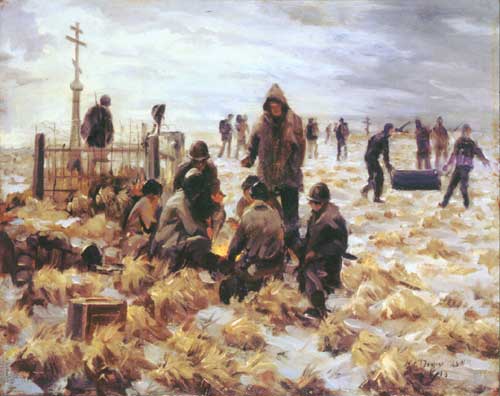
|
| Rest in Peace (Soldiers Pause During Landing Operations), painting by William F. Draper, oil on board; 1942. Navy Art Collection, Department of the Navy, 88-189-AM. |
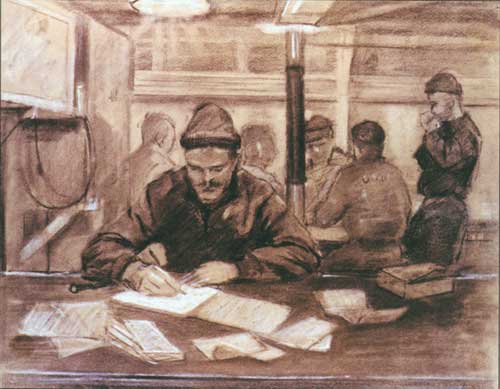
|
| Aleutian Interior, painting by William F. Drape, charcoal, 1942. Navy Art Collection, Department of the Navy, 88-189-U. |
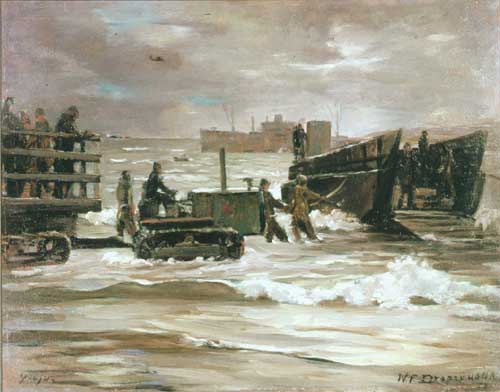
|
| Aleutian Landing (Beaching a landing boat), painting by William F. Draper, oil on board; 1942. Navy Art Collection, Department of the Navy, 88-189-AN. |
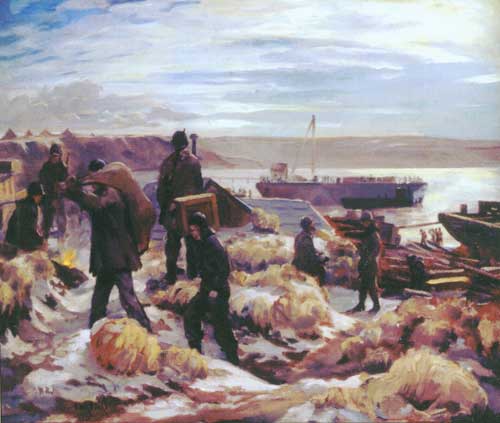
|
| Supply Line's End (Supplies being brought up from the beach), painting by William F. Draper, oil on board, 1942; Navy Art Collection, Department of the Navy, 88-189-AO. |
In addition to the decline of marine fur-bearers and the trendy fashion whims of distant markets, the economic importance of fox farming in the Aniakchak region was secured primarily due to the role of the federal government. Beginning in 1882, the United States Secretary of the Treasury oversaw the leasing of islands for propagation of foxes. Viewing fox farming as a way to increase population to the territory and expand Pacific markets, the government used its relationship with the media to advertise the economic potential of the industry. In a memorandum to the press, the Department of the Interior stated, "Foxes grown here in the far North have a heavy fur superior to that of those grown in warmer climates." According to the memo, "a most advantageous location of a fox farm is on any of the numerous small islands that fringe the coast of Alaska. On these islands fencing was unnecessary to prevent the animal from escaping and fish which is likely to be the chief food for the foxes is easy to procure." [19]
Not only did corporations like the Alaska Commercial Company lease islands, but also the U.S. government made the numerous islands off the shore of Aniakchak available to individuals. By 1920, many of the islands near Aniakchak were stocked with fox by Euroamerican men married to local Alutiiq or Creole women. [20] Frank Lowell, a regional trader for the Alaska Commercial Company, stocked Ugaiushak Island with blue fox in 1915, and in the 1920s, Ben Benson took it over and it became known as Benny Benson's Island. George Anderson, with his wife, Ocelena, started raising foxes on Chankliut Island near Castle Cape as early as 1910. His son-in-law, Lars Hanson, had the lease in 1920 when Anderson, five children and two grandchildren and Hanson were all living on the island. Charles W. "Charlie" Olsen, a Norwegian, and two Germans, Adolf Von Himmel and Charles Weideman, were living on Unavikshak in 1920, where Charlie Olsen had begun farming foxes. This island is locally known as "fat Charlie Olsen's Island." Olsen had good access to salmon streams on Cape Kumliun where his barabara stood. Alex Carlson, Sr. stocked Kumlik Island in the 1920s. He lived in a large frame house on the island every fall and spring and had a barabara on shore from which he and his sons trapped in the winter. Pete Pedersen married Charles Brandal's daughter, Anne. They started a fox farm on Nakchamik Island in the 1920s. [21]
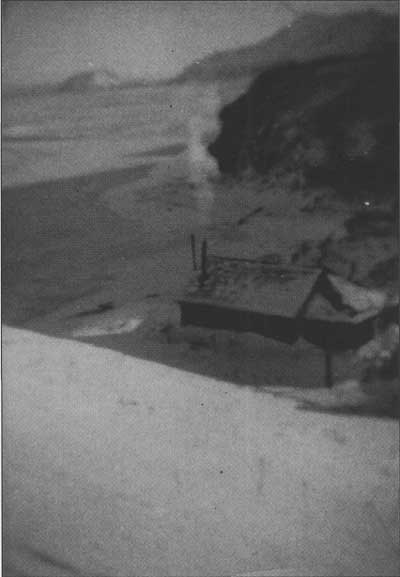
|
| Pete and Annie Pedersen's cabin at Aniakchak Bay, ca. 1920s. Photograph courtesy of Alec Pederson, Chignik Lagoon, Alaska. |
The government charged these individual fox farmers $200 per year to lease an island, which totaled up to $1,000 for the duration of a five-year lease. [22] The government even supplied farmers with blue fox from stocks held on the Pribilof Islands. Most of the men who applied for a lease had never run their own business. To overcome this hurdle, the government instructed fox farmers on modern principles of business practices. For example, the Department of Commerce published what the agency described as "a plan for success," which provided new fox farmers with a business formula consisting of "capital invested," "operating expenses," and "prices that skins will bring." The government advised farmers to be patient with this plan: for "the conservative man, who goes into the business after carefully considering all the conditions and who does not easily become discouraged, may hope to meet with reasonable success." [23] Many residents—Alutiiq, Creole, and Euroamerican—took the government up on its offer. By 1922, there were over 150 recorded fox farms in Alaska, several of which were located off the coast of Aniakchak. [24] By 1930, when Hubbard and his crew passed through the region, fox farming was the third largest industry in Alaska, surpassed only by fishing and mining. [25]
Chignik resident, Helen Neilson, whose father was Scandinavian and mother was Native, lived on a fox farm with her family between 1925 and 1935. Neilson recalls, "Everybody had foxes, raised them on their own islands, but we had Nakchamik." The Neilsons, typical of most fox farming families in the Aniakchak region, brought a couple of foxes from a nearby island and the entire family participated in raising the foxes. [26] "We'd feed the foxes bran mixed with fish or sometimes meat, like seal meat, sea lion, and fish; mix it with bran and cook it," recalled Helen. "We'd always go fishing and bring home lots of fish for the foxes. We'd go seal and sea lion hunting also. The foxes ate anything wild. Sometimes we'd bake the fox meal into loaves of bread, then we'd slice it up and give the foxes so much each day. 'Course they ate that!" [27] In an interview conducted by Susie Pedersen, Nielson explained how her family killed the foxes:
We'd set the box traps where we regularly fed them before, at the feeding places. The way we caught the foxes was we'd set a bait in the box trap, and the fox would get in and get the bait. When he gets the bait, he shuts the door, it automatically shuts him in. We'd go there every day, get them out of the trap, and kill em. We'd use tongs and get them around the necks, and haul them out through an opening at the top of the box. Then we laid them down and put our knees on their hearts until they died. I didn't like to do that, but we couldn't hurt the skin. [28]
Besides impacting the social and economic character of the Aniakchak region, such activities changed the physical environment. Although fox farming was fleeting and was conducted by a relatively small number of individuals, nevertheless, the enterprise caused significant changes to the island on which the farming took place.

|
| Unidentified family at Pilot Point, ca. 1920s. Photograph courtesy of the Pilot Point Tribal Council, Ace Griechen Collection. |
Historically, those who depended upon sea birds for part of their subsistence lifestyle were quite aware of the impact of fox farming on sea birds. The indigenous islanders, as well as the Russians, felt the pinch when they had to travel to other islands to hunt sea birds for skins and feathers because of the scarcity of these birds on their regular hunting grounds. According to Ebbert, by 1812, many Aleuts had to switch from making clothing from bird skins to substituting with other materials. [29] Likewise, numerous biologists from William Dall to Olaus Murie documented years of ecological change after Alaska had become an American territory. In 1932, President Herbert Hoover created the Semidi Islands Wildlife Refuge, but frustrated many regional scientists by providing that the new sanctuary maintain dual and competing purposes—breeding both birds and fur-bearing animals. Because biologists had become convinced that island ecosystems could not support both foxes and birds, it was Murie who formally objected in 1936 to the incompatible uses of the islands as both fox farms and bird sanctuaries. Murie's warning fell on mostly deaf ears, and, as a result, in a report for the journal Science, today's biologists describe the introduction of predators to coastal islands during this time as possibly, "one of Alaska's worst ecological disasters." [30]
On most islands, fox farmers fed the animals fish and marine mammals. When fox pelt prices plummeted in the 1930s and sale of salmon to canneries generally became more profitable, consequently foxes no longer were fed by their keepers. The foxes, then, preyed upon the millions of nesting seabirds that used the islands as rest stops during their long, continental and ocean spanning migrations. The foxes preyed upon the seabirds' nests, eating their eggs, which devastated reproduction success. Before the foxes died out due to starvation or eradication, these efficient predators nearly drove the Aleutian Canada Goose to extinction and decimated other species, but according to biologists, the damage went even further. The recent study compared eighteen similar sized islands—nine that supported fox farms and nine that did not. The study revealed that that those islands without foxes maintained a very different ecosystem than those that had foxes.
The treeless island ecosystems of southwestern Alaska widely depended upon the guano dropped by millions of seabirds to fertilize the islands' shallow soil. As foxes killed the unprotected nesting seabirds, the islands lost the capacity to support what had been lush grassland. According to Vernon Byrd, supervising biologist with the Alaska Maritime National Wildlife Refuge, "What once was an ocean of beach rye and other dense growth transformed into a scruffy tundra dominated by dwarf shrubs and leafy plants." [31] By removing a key species from the isolated island habitats, fox farmers caused the food chain to unravel, affecting everything from the microbes in the soil to the winged creatures overhead. [32]
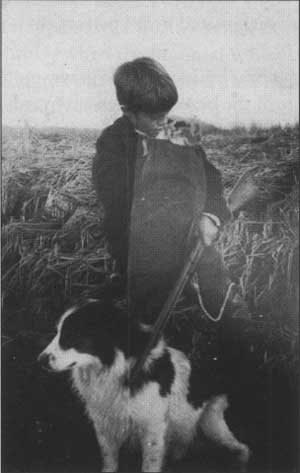
|
| Alec and his dog "shep" head out to hunt birds, ca. 1920s. Photograph courtesy of Alec Pederson, Chignik Lagoon, Alaska. |
Decline of the Fox Farms
Due to the declining sea mammal numbers, as early as 1902, the Alaska Commercial Company had closed most of its trading posts on the Alaska Peninsula, and in 1907, Omar J. Humphery and W.J. Erskine of Kodiak purchased what was left of the company's holdings. [33] Although the sale meant an unceremonious end of fur trade, one thing was for sure, the Alaska Commercial Company, with its vessels, capital, and employees, had put the Alaska Peninsula on the map for industries to come and paved the way for a new American era.
While one strand of the fur trade, fox farming, continued on in piecemeal along the peninsula coast, by the 1930s, it too had come to an end in the Aniakchak region. The first few years of the decade saw a sharp decline in fur prices brought on by the Great Depression. Although 431 fur farm licenses were issued in 1931, the value of furs shipped from Alaska declined more that fifty percent from the previous year. In 1929, the zenith of fox farming, 9,300 blue fox pelts valued at nearly $900,000 were exported from Alaska, but by 1931, this value had fallen to less than $200,000. Arctic fox pelts dropped from an average of $108 in 1929 to $65 in 1930 and only $32 in 1931. Commercial fur endeavors largely collapsed during the Great Depression and never recovered. [34] Although the collapse of the international fur market ended the commercial fox farming industry, fox farmers were only on the cusp of change that was occurring across the Alaska Peninsula.
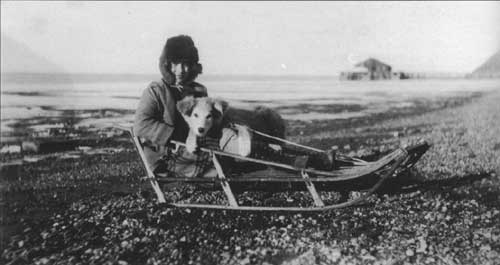
|
| Waiting for snow! Note the Ugashik Cannery in the background. Photograph courtesy of Ace Gretchen, Pilot Point, Alaska. |
Trappers
The popular image of the frontiersmen in the early decades of the twentieth century was one of rugged individualism, a timely image that Father Hubbard with his Moon Crater myth was glad to incorporate. But by the explorers' own accounts of Aniakchak, the people whom they encountered there were anything but stoic loners living off the land. For example, when Hubbard's team ascended into the Caldera on their second trip in 1931, they began their trek by staying one night at Alec Brandal's cabin, which is still located on Kujulik Bay. "We took a look around us after we had carried the equipment up to the cabin," recalled Douglas:
It was much better than the average winter cabin of a trapper. It's one big room and small outer room, where hung traps and drying frames, were sturdily built and had double windows on the ocean side. Apparently the owner lived there with his wife and children, as we saw an old dress hanging on the wall and a pair of child's shoes under the bed in one corner. [35]
Most of the families who maintained fox farms in the Aniakchak region almost always supplemented their income by trapping in the winter. Trappers mainly pursued fox, but they also trapped mink, ermine, land otter, wolverine, and occasionally wolves. Their trap lines extended along the region's numerous creeks, rivers, and into Aniakchak's open areas and bear trails along the coast. [36] In the mid-1890s, early trappers like Brandal's father, Charles; George Anderson; and George Morris sold or traded their pelts at local Alaska Commercial Company trading posts. [37] By the 1940s, when families like the Ericksons, Pedersens and Grunerts were still trapping in Aniakchak, trappers sent their pelts off to markets through the U.S. mail. [38] Over time, trapping proved to be a viable strategy for cashing in on the lucrative but capricious fur market.
When Hubbard arrived in 1930, the Aniakchak landscape was definitely not a wasteland void of people. A number of trapper families made their home along the Alaska Peninsula coast, many of whom lived within the boundaries of the current monument and preserve beginning as early as 1920, until World War II. In about 1925, Alec Brandal built a cabin on the North Fork River on Kujulik Bay, the same cabin used by Hubbard and his crew to access the Caldera in 1931. According to Douglas, the cabin was situated in the perfect environment:
The cabin was built on a little grassy mound at the edge of the beach. Not twenty yards from the door, a small stream that ran from the mountains down to the lagoon gave us plenty of good water. The lagoon made an ideal place to moor the plane. Sheltered from the ocean by a long sand dune, it was always calm. At the head of the lagoon was a wide expanse of mud flats fringing the marsh, but when the tide was high the flats were covered and ducks came in their from the ocean. [39]
But not all Aniakchak residents lived so well, for only those who could afford it brought lumber in and built framed homes along the treeless coast. Many homes were, in fact, modified barabaras, which included sod roofs, timber floors, and perhaps small windows or wooden doors. Trappers used whatever material was available. Discarded cotton webbing from fish traps, driftwood, and willow and alder branches served as suitable material to build homes, caches to protect food, or sheds to protect boats hauled up on the ways. [40]
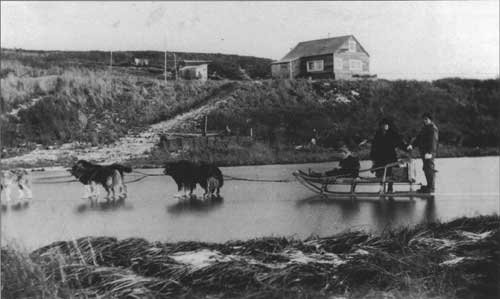
|
| Dog sledding the hard way! Virginia Hanson is sitting in sled, Florence Hanson is standing, Virgil Hanson is standing on runners of sled on China Lake, ca. 1930s. Photograph courtesy of the Pilot Point Tribal Council, Ace Griechen Collection. |
Most trappers lived in Aniakchak during the long winter months—when the mountains blocked the winter sun in Chignik but still reached their homes and trap lines on the south coasts of Amber, Aniakchak and Kujulik bays. Besides his fox farm on Kumlik Island, Axel Carlson maintained a cabin along with several barabaras on Cape Kumlik from which he and his brother could trap in the winter. Charlie Olsen had a similar situation on Unavikshak Island where he ran a fox farm. On the mainland, Olsen not only had a cabin on Cape Kumliun, but also had built other trapping cabins on the south end of Kujiulik Bay, and on Meshik Lake at the head of Meshik River. Charles Weideman's maintained several trap lines, which extended up the Aniakchak River, where he had at least one cabin. After the collapse of the fox farm industry, the Pedersen family took over Weideman's trap lines and lived in Aniakchak Bay from 1934 until 1943. Pedersen's many children expanded Weideman's line up the Aniakchak River drainage and to Meshik Lake. Albert Johnson maintained a cabin on the aptly named Albert Johnson Creek, a tributary of the Aniakchak River. Fred Gungas had a barabara on the south coast to Cape Ayutka where he trapped. Adolph Von Himmel trapped the east side of Aniakchak River and Main Creek in Amber Bay and maintained both a cabin and boat haulout there. John Hillborn bought Von Himmel's cabin, boat, and traps in the 1930s when Von Himmel returned to Germany after the war in Europe began. [41] Instead of a long single procession, Hillborn organized his newly acquired trap lines in the form of a fan, with his cabin as the apex. "I get as many furs by laying several short lines," explained the trapper, "this is probably because I can give my traps closer attention, covering an entire wing each day." [42]
Trappers worked lines on the Bristol Bay side as well. Whereas Chignik was a hub for the Pacific side, Port Heiden became the point of access for many of the trappers working the tundra-covered slopes of the north and west side of the Aniakchak Caldera. George "Scotty" Irons and his wife, Mabel, built a large cabin on Scotty's Island in the Meshik River. Sam Supsook, another Bristol Bay trapper, was one of the many Inupiaq who had moved his family to the Alaska Peninsula from the Seward Peninsula. Supsook had a cabin on the North River, which flows from the northwest side of Aniakchak Crater. [43] Supsook's son, Valentine, and his wife, Pauline, trapped near Cinder River in the 1930s. They had a small cabin on the river. The couple met when Valentine helped Pauline's father, William Zunganuk, corral his reindeer at Reindeer Creek. [44]

|
| Trapping cabin on the upper King Salmon River, located just north of the Aniakchak National Monument and Preserve, date unknown. Photograph courtesy of the Pilot Point Tribal Council, Ace Griechen Collection. |
It was during these years that Hubbard and his crew noticed Native people trapping along the flanks of Aniakchak:
Today the younger men of the Aleuts set traps on the slopes of the mountains and laugh at their elders. But the old men cling steadfastly to their fantastic beliefs and refuse to go near the volcanoes. [45]
Though Douglas probably exaggerated this observation, it is important to point out that the "Aleuts" encountered by Hubbard were probably either descendants of Inupiaq from the Seward Peninsula, or persons of mixed Alutiiq, Russian, and Scandinavian heritage, and therefore, were affected by an array of influences that shaped an individual's relationship with the surrounding landscape. Chignik elder Julius Anderson trapped both sides of Aniakchak and never thought too much about the volcano. Still, Anderson never approached or entered the Caldera: "Why should I?" asked the aged trapper, "it's nothing but a big hole in the ground." [46]
Olaf Matson, born in Larvik, Norway, married Annie Abyo from Chignik and together they maintained several trapping cabins. One cabin was built on the Meshik River at a place called Ameguduk; another was located somewhere along Tunangapuk (Birthday) Creek. In a recent interview, an elder from Port Heiden remembered how Matsen used to trap, travel, and trade throughout the entire region:
He came from Norway, and he used to walk over there...he was trapping. He'd walk across—bring caribou meat over there, and go get some Codfish. And, this guy, he had an old friend over there. Another Norwegian, I guess—come over—trade meat for fish.
When asked if Matsen traveled on foot or by dog team, the informant recalled a story that illustrates how the volcanic landscape often served as an obstacle for the Bristol Bay trappers:
On foot. He had no snow there, little ways you know. But, he got into a big storm, blowing those big boulders—pumice stone, you know—those big rocks. He had a tough time. Another guy too—he hiked across there—he had to turn back. Almost got the best of him—rolling rocks. [47]
Aniakchak's fierce pumice storms were not the only threat trappers had to overcome. As John Hillborn described in an article he wrote for the Alaska Sportsman in 1937, "I've been trapping in Alaska for fourteen years, now—all of them in the open county between Chignik and Aniakchak. During that time I've had some hair-raising experiences." [48] Most of those "hair-raising experiences" included encounters with the coastal Alaskan brown bear. "I didn't notice Old Bruin until she was nearly on top on me," recalled Hillborn. "She kept coming, and snorted as she came. I could see that she was hungry, and the she didn't intend to be cheated out of her meal." Though the bear was killed by a lucky shot, Hillborn knew that luck in the bush was brief at best. Consequently, Hillborn taught his children to be observant, to always scan the country for bears, and never to surprise one. [49]
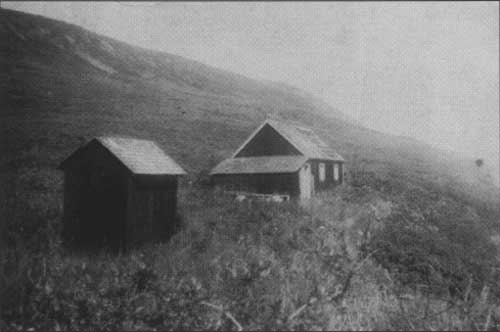
|
| The Pedersen's fox farm, ca. 1920s. Photograph courtesy of Alec (Teetum) Pedersen, Chignik Lagoon, Alaska. |
The risks involved in living the trapper's life threatened not only the trapper, but his family as well. For instance, while Olaf Matsen was out trapping the line one winter in 1917, his son, Henry, was delivered solely by his mother, alone at their cabin on Birthday Creek. [50] Matters were worse for the Carlson family when Axel Carlson Sr.'s wife, Evelyn, died of tuberculosis in 1926. With no one to raise the children while Carlson trapped, the children were sent to orphanages until Carlson remarried and began his fox farm on Kumlik Island a year and a half later. One elder from Chignik Lagoon remembers those times as a hard way to live: "Most the elders started farming foxes, the blue foxes, on the islands around here. Lot of them used to go out east and go trapping. You would get to trap and hunt. That's the way they lived. Then if you built a house you would have to come up with materials to build it with. It was tough—no kidding." [51]
As hard as life was for the trapper and his family, it was also what many remember as being a good life. A new generation of Aniakchak trappers was raised along the monument's rivers and bays and many are still alive today. Although this generation of Aniakchak trappers grew up outside of the communal life of the village, none recall living a life of isolation, either. As Michele Morseth points out, "the families in Aniakchak and Kujulik bays not only established working trap lines, but social paths as well." [52] Running between their houses were local routes, trampled by bears and men in the early decades of the century. Some routes were so popular that the trappers named them. For example, the most used trail was "The Boulevard" which went along Aniakchak Bay from the river mouth to the lagoon. Axel Olsen Jr. remembers a communal cabin that nearly all trails reached. The local trappers called it the "halfway shack:"
It was a halfway shack they called it you know you go up there and stay for one night. Then he goes on from there the next day camp up and come back to that cabin again, whatever he gets and takes care of it then he goes home the next day. That's what his routine was and then he takes a day or two off when he gets home and then start the whole thing over again (laughs) go back up. [53]

|
| On the fox farm even the kids had chores like feeding the pigs, ca. 1920s. Photograph courtesy of Alec (Teetum) Pedersen, Chignik Lagoon, Alaska. |
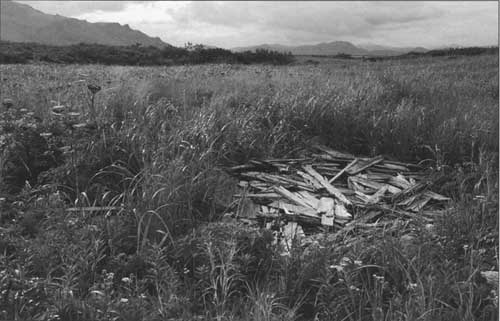
|
| Remains of the razor clam cannery, 2005. Photograph courtesy of Ross Smith, NPS. |
Trails, which connected houses, cabins, and barabaras, extended from Amber Bay to Aniakchak to Kujulik Bay and all the way to Chignik Lagoon. Trails from Aniakchak and Kujulik Bay that accessed the interior met at Albert Johnson Creek and went all the way down the Meshik River to Port Heiden. A strong trapper could make the trip in seventeen hours. Because foot travel was the best way to get from place to place, a walk from Chignik to Aniakchak Bay might take eight days. And along the way, a trapper might stay with as many friends and relatives. [54]
The trapping lifestyle continued in Aniakchak until the 1940s. During the years consumed by World War II, fur prices dwindled even further and young men went off to work for the war effort or join the armed forces. For many, the war put an end to the lifestyle that dominated the first four decades of the twentieth century. In Port Heiden, where the U.S. Army built a base and airstrip, the advent of World War II particularly changed local lifeways. "Yeah, it changed quite a lot after the military came in here," recalled an elder from Meshik:
I think it was '43 they came in here—a lot of roads and stuff. Yeah. Then we quit going trapping after about '43, I guess. My brother went into the service. Then we kind of stayed over at Port Heiden and never trapped. The people quit trapping after that. . .I guess the main reason was the price of fur went down and wasn't feasible anymore. Just to go out and trap, you couldn't make much money. [55]
Other notable influences brought about the end of trapping. As Michele Morseth suggests, "the post-war life style included neither the hardship nor rewards of moving families to remote cabins to run trap lines." She notes that the establishment of wintertime schools, the impact of the influenza epidemics, and more centralized economic opportunities also brought about change. [56] As Chignik Lagoon elder recalls, "We salted [fish] a lot, hunted, and trapped, but trapping was a losing battle." [57]
After World War II, commercial fishing finally offered enough income to support a family, and opened up the door for local people to enter. After statehood in 1960, fish traps were outlawed. This increased local participation in the commercial fishery, as more and more families traded in their trap gear for fishing nets, seiners, and gillnetters. Instead of fox farmers and trappers, the Knights of Woeful Countenance became fishermen. Family life became far more sedentary, as many moved to year-round villages, situated next to one or more of the numerous salmon canneries, served either by the Bristol Bay or Chignik fishery. By the 1950s, most people were living in the fishing villages of Chignik Bay, Chignik Lagoon, Pilot Point, Ugashik, and Port Heiden, and had left their cabins in Aniakchak to the elements.
Razor Clamming
Local fisherman could not access the fishery during the first few decades that the canned salmon industry operated their canneries and traps on the Alaska Peninsula, with this prohibition remaining in place until the watershed years of World War II. By the turn of the century, the trend to consolidate fish companies made the canned salmon industry in Alaska more stable, but it also meant that it was more difficult for a new generation of companies and fishermen to enter the fishery. To compete, many of these newcomers looked to diversify their product. Consequently, a few canneries exploited the rich razor clam beds of the Alaska Peninsula in hopes of expanding their markets. These now well-known beaches included the rich clam beaches of Tuxedni Bay on the coast of Lake Clark National Park and Preserve, Swikshak Lagoon on the coast of Katmai National Park and Preserve, and Aniakchak Bay in Aniakchak National Monument and Preserve. Though the latter was the least significant to the Alaska Peninsula clam canners, it still, nonetheless, reflected aspects of the larger clamming industry, as well as the ingenuity and perseverance maintained by so many of the clamming entrepreneurs in the decades of the twentieth century.
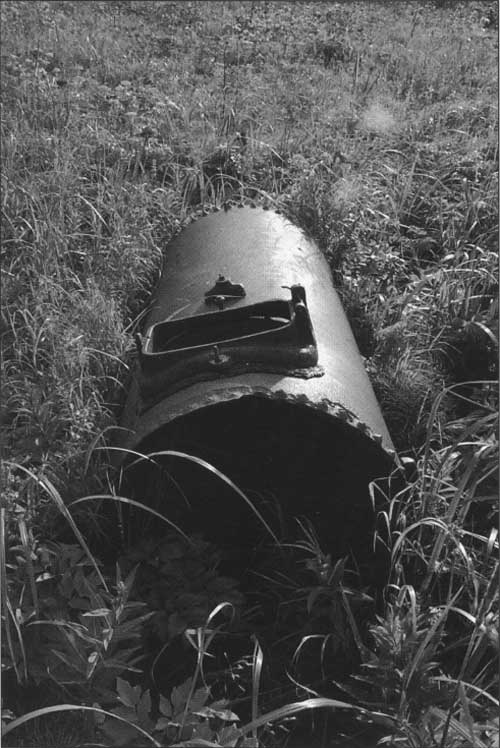
|
| The retort was used to cook the canned clams, 2005. Photograph courtesy of Ross Smith, NPS. |
The Pacific Coast canned clam industry expanded to Alaska in 1915, when the Lighthouse Canning and Packing Company prepared the first northern pack of razor clams in Cordova, Alaska. G.P. Halferty's Pioneer Packing Company, the most successful clam canner of the day, soon followed. The rich clam beds of the Alaska Peninsula, though used extensively by indigenous Alaskans for centuries, were discovered for commercial purposes when Washington state clam canner, Elmer Hemrich, came to Alaska to prospect sites for a cannery in 1917. Beginning his quest in Chignik, Hemrich traveled north along the coastline, and thusly opened the clam beaches of Swikshak Lagoon and Tuxedni Bay to commercial interests. [58] Only two years later the Surf Packing Company from Aberdeen, Washington built the Snug Harbor cannery on the southwestern end of Chisik Island, just off the coast of the current Lake Clark National Park and Preserve. [59]
When the clam canning process proved to be less profitable than the salmon canning process in Cook Inlet, in 1923, Hemrich moved the Surf Packing Company to Kukak Bay, located in what is today Katmai National Park and Preserve and operated there under the newly reorganized company, the Hemrich Packing Company. [60] Despite poor clam seasons, strong competition from East Coast clammers, even a fire that burned down the cannery in 1936, Kukak was the most successful razor clam operation on the Alaska Peninsula, running off and on, under the direction of four different companies, until 1951. [61] The successful diversification of the seafood industry made it possible for at least one entrepreneur to exploit the abundant razor clams found in Aniakchak Lagoon in the early 1930s. On July 20, 1932, Axel Olsen filed a "Notice of Location" at the Unga Peninsula District's recording office with the intent to establish a clam cannery on the southwestern end of the bay. [62]
It comes to no surprise that Olsen jumped on the razor clam bandwagon in 1932, for the industry produced one of its largest packs in Alaska that year. Alaskan clam canners produced 69,147 cases, nearly twice the amount of clams packed the previous season. [63] Olsen contributed 12,948 pounds of clams to the Alaskan pack that same season. [64] Besides numerous clam beds, Aniakchak Bay offered Olsen a favorable location for his cannery because the beach provided easy access for anchorage and the Lagoon protected his structures from fierce southerly winds.
Olsen likely began harvesting Aniakchak razor clams in April before the first minus tide of May. He continued to collect his prey throughout the minus tides of summer. Olsen had no commercial competitors in Aniakchak, so the clammer could work at his own pace. Still, clamming was anything but leisurely—digging for clams was extremely labor-intensive. The clammer dug the clams from the black volcanic sandy beaches, using a shovel, and filled one wooden Blazo Box at a time. Like the cannery operations at Swikshak and Tuxedni, Olsen hauled clams from the beach to the cannery by automobile. Though the cannery exists today as a pile of rusted machine parts and wooded rubble, archeological evidence shows that the cannery probably consisted of one, or at the most two, buildings. Also found among the rubble was a deep heavy sink, where Olsen probably cleaned the clams and checked cooked cans for "floaters, or tins filled with contaminated air. In addition, a sole retort, which Olsen could have brought up from Chignik, was used to cook his entire pack. [65]
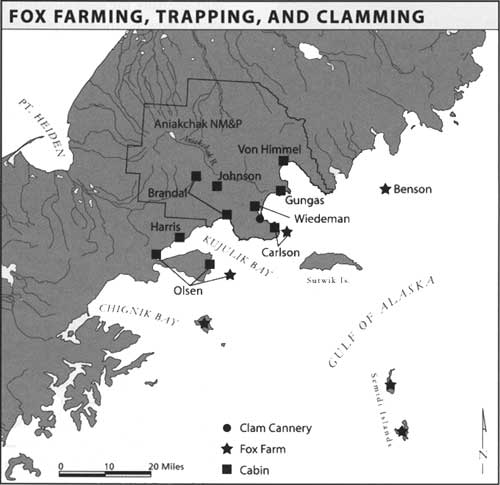
|
| Fox farm, clam cannery and cabin sites. By B. Bundy. Source Morseth, 2003. (click on image for a PDF version) |
There is no indication that Olsen hired employees to either dig or can razor clams. He never incorporated his business into a company. Olsen's cannery was probably similar to the family run, hand-pack outfits that were operating at Polly Creek about the same time. Because these canners operated on such a small scale, they belong to a category of canners who more resembled the subsistence operations found in Russian and Native settlements than the complex, commercial operations of the Snug Harbor and Kukak plants. These small hand packers may have devoted countless hours of hard work and perseverance to their clamming operations, but invested little capital. [66] Olsen, like other small hand-packers, simply added canning clams to his repertoire of hunting, fishing, and trapping activities in Aniakchak.
According to local sources, Olsen's cannery eventually failed because the clams were too sandy, transportation costs too high, and that the clam population declined under heavy harvesting pressure. [67] Industry reports show that this was the case throughout Alaska, for the razor clam production curtailed in all districts after 1932. The drain on the Alaska beds was so heavy that year that regulators imposed packing quotas in some districts by 1932. By 1935, those quotas reached western Alaska beaches. [68]
Although the clamming industry rebounded by 1938, it appears that Olsen gave up trying to make his cannery a commercial success. After his death, his three sons, Edwin, Axel Jr., and Rudy Carlson, moved into the clam cannery, making living quarters out of one end and using the rest for storage. In the end, the clam cannery became a base camp for trapping, another occupation facing its waning years. Over the decades, the structure has been dismantled for its more valuable material. Some have recycled the material for other practical uses, whereas others have simply vandalized the site. Further archeological investigations focused on Olsen's clam cannery may provide valuable information concerning a unique industry in Alaska's history. [69]
* * *
The activities conducted by these men and their families back in the 1920s continue, in some capacity, in contemporary times. As Pat Partnow notes in her study of the peninsula, "This pattern of seasonal contraction and expansion continues today, as families eagerly await the freedom and relative solitude of fish camps each summer, then return to group activities each fall." [70] Though only a few ramshackle cabins are all that remain from this time period, many people who still identify with the region continue to fish, hunt, or pick berries in Aniakchak.
Today, the many residents from Chignik and Port Heiden who can link their family heritage back to the era of fox farming and trapping are products of the long continuing history of the Knights of Woeful Countenance and their association with the Aniakchak landscape. As fox farmers were unknowingly transforming island ecology, and trappers and clam canners were linking Aniakchak to larger patterns of industry, most Americans had no idea such activities even existed. To most people, if they ever even thought about the Alaska Peninsula, they saw the northern appendage as a blank space on the map.
It wasn't until May 1931, when the mountain woke, that the rest of the world discovered Aniakchak. And, if it weren't for the timely return of Father Bernard Hubbard to the region that spring, there is a good chance that few Americans, including National Park Service personnel, would ever have heard of Aniakchak. Although Alaska had been a part of the United States since 1867, the general public saw the Far North as a foreign land of igloos and polar bears—nothing about the place resembled America. During the 1930s, however, when Hubbard began to alert the federal agency, as well as the American public, to Aniakchak's natural worth, the Glacier Priest put the Caldera and the entire central Alaska Peninsula on the American map. While Father Hubbard dispelled the notion that the Alaska Peninsula was a foreign icebox, he downplayed images of it as a home to local families, preferring to stir his audiences with the sense that this was the place where a man could test his courage and conquer nature on America's last frontier.
NOTES
1Douglas, In the Land of Thunder Mountains, 7.
2Non-Orthodox males in Chignik Lagoon/Nikolaevskoe 1899-1914, ANIA File, Lake Clark Katmai Studies Center, Anchorage, AK.
3Sherwood, Exploration of Alaska, 1865-1900, 5.
4Susan Kollin, Nature's State: Imagining Alaska as the Last Frontier (Chapel Hill: University North Carolina Press, 2001), 5.
7Mishler and Mason, see Partnow, 143.
8Julius Anderson, interviewed by Katherine Johnson 7/20/2004.
10Douglas, Land Of Thunder Mountain, 16.
11Edgar P. Bailey, "Introduction of Foxes to Alaskan Islands—Historical Effects on Avifauna, and Eradication" (Washington D.C: Fish and Wildlife Service, 1993), 8-9.
12Steve Ebbert, personal communication, 10/21/2005.
14"The Semidi Propagating Co.: 1889," in the Alaska Commercial Company records, Correspondence of the Kodiak Post, 1868-1891, UAA, MFR 1.
18Harriet Rossiter, "Alaska's Fur Industry: Its Decline and Rise," Fur Trade Review, circa 1920s: 174.
19Department of the Interior, Memorandum for the Press, October 6, 1928. 1-2.
22H.M. Smith, Commissioner of Fisheries, Department of Commerce, Bureau of Fisheries, Memorandum Regarding Fox Farming, August 1, 1913. Microfilm reel 144, Alaska and Polar Regions, Rasmussen Library, University of Alaska Fairbanks.
24Although over 150 islands were recorded as fox farms, many were stocked illegally without leases. Bailey, 9 and 11.
27Susie Pedersen, "Helen Nielsen: Life on a Blue Fox Island," in The Cama-I Book (New York: Doubleday, 1983), 81-83.
30D.A. Croll, J.L Maron, J.A. Estes, E.M. Danner, G.V. Byrd, "Introduced Predators Transform Subarctic Islands from Grassland to Tundra," Science Vol. 307. March 25, 2005: 1959-1961.
31Anchorage Daily News, "Bird loss reverberates on islands," May 14, 2005: B-1.
33Alaska Commercial Company Director' Meeting Minutes, Dec 26, 1906, Correspondence of the Kodiak Post, Alaska Commercial Company Record, 1868-1891, Microfilm. University of Alaska Anchorage Archives.
38Clarence Erickson, interviewed by Katherine Johnson 7/19/2004.
42John Hillborn, "Chignik Trapper," Alaska Sportsman, December, 1937, 12.
47From Neqa to Tepa, Alaska Department of Fish and Game, 283-OAM-081501.
51From Neqa to Tepa, Alaska Department of Fish and Game, 087-OJA-112002.
53Axel and Alva Carlson in Chignik Lake, 25H98-04-02, Box 1 Folder 10, Lake Clark Katmai Studies Center, Anchorage AK.
55From Neqa to Tepa, Alaska Department of Fish and Game, 283-0AM-081501, 2002.
57From Neqa to Tepa, Alaska Department of Fish and Game, 087-OJA-1122002, 2002.
58Katherine Johnson, Buried Dreams: the Rise and Fall of a Cannery on the Katmai Coast (Anchorage: National Park Service, 2002), 15.
59For more information see Katherine Johnson Ringsmuth, Beacon of the Forgotten Shore: Snug Harbor Cannery, 1919-1980 (Anchorage: National Park Service, 2005).
62Norris, Isolated Paradise, 431.
63"Pacific Clam Canning," Pacific Fisherman Yearbook, 1937.
65Ross Smith, personal communication, June, 2005.
66Ringsmuth, Beacon on the Forgotten Shore, 38.
68Richard Nickerson, A Critical Analysis of Some Razor Clam Populations in Alaska (Juneau: Alaska Department of Fish and Game, 1975), 2-3.
| <<< Previous | <<< Contents>>> | Next >>> |
hrs/chap7.htm
Last Updated: 03-Aug-2009